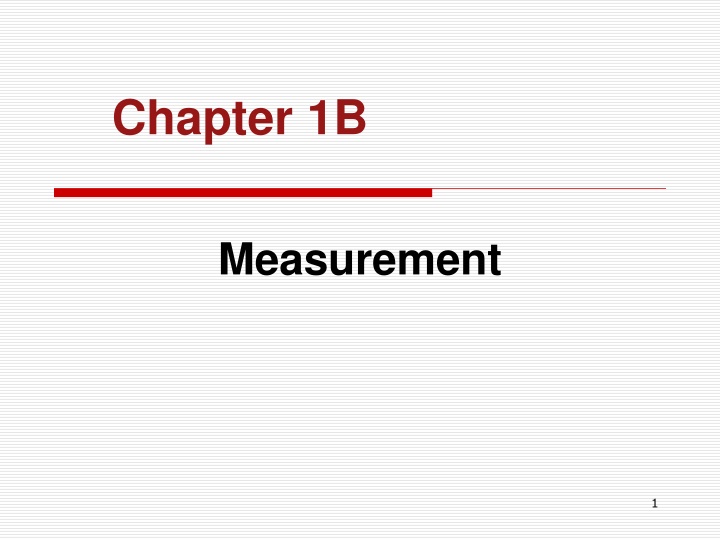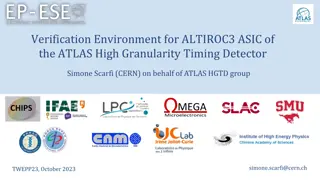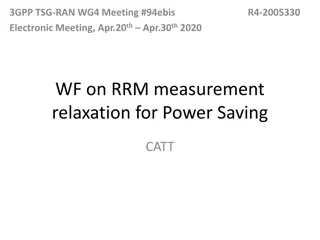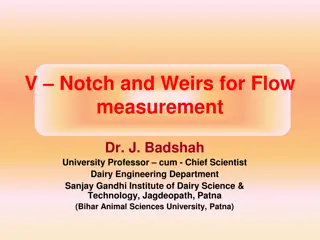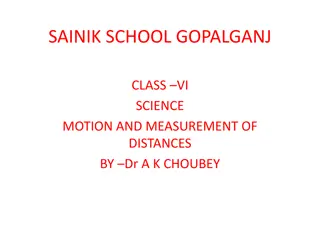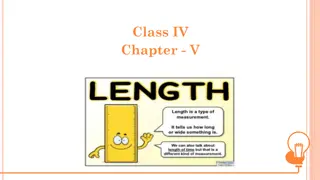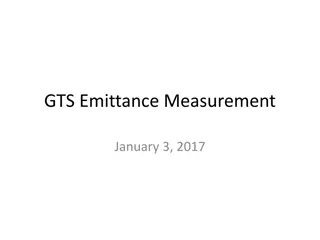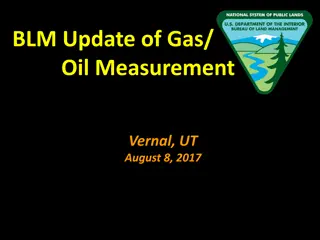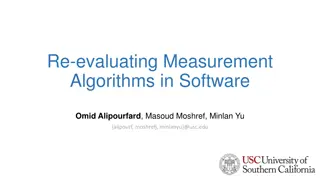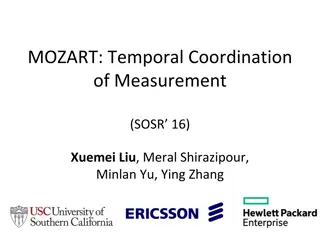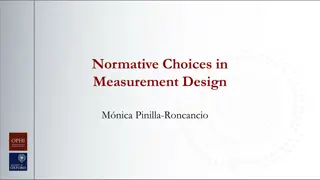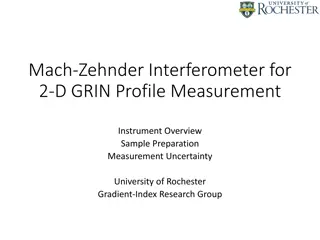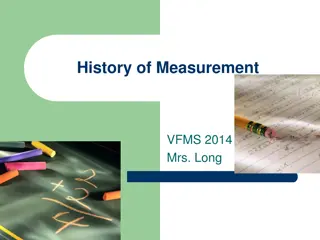Measurement in Chapter 1B
Introduction to measurement concepts and techniques covered in Chapter 1B. Explore various methods to quantify and analyze data, essential for scientific experiments and research.
Download Presentation

Please find below an Image/Link to download the presentation.
The content on the website is provided AS IS for your information and personal use only. It may not be sold, licensed, or shared on other websites without obtaining consent from the author.If you encounter any issues during the download, it is possible that the publisher has removed the file from their server.
You are allowed to download the files provided on this website for personal or commercial use, subject to the condition that they are used lawfully. All files are the property of their respective owners.
The content on the website is provided AS IS for your information and personal use only. It may not be sold, licensed, or shared on other websites without obtaining consent from the author.
E N D
Presentation Transcript
Chapter 1B Measurement 1
CHAPTER OUTLINE SI Units Scientific Notation Error in Measurements Significant Figures Rounding Off Numbers Conversion of Factors Conversion of Units Volume & Density 2
SI UNITS Measurements are made by scientists to determine size, length and other properties of matter. For measurements to be useful, a measurement standard must be used. A standard is an exact quantity that people agree to use for comparison. SI is the standard system of measurement used worldwide by scientists. 3
SI BASE UNITS Quantity Measured Length Mass Time Temperature Amount of substance Electric current Intensity of light Units Meter Kilogram Seconds Kelvin Mole Ampere Candela Symbol m kg s K mol A cd 4
DERIVED UNITS In addition to the base units, several derived units are commonly used in SI system. Quantity Measured Volume Density Units Liter grams/cc Symbol L g/cm3 5
SCIENCTIFIC NOTATION Scientific Notation is a convenient way to express very large or very small quantities. Its general form is A x 10n n = integer coefficient 1 A < 10 6
SCIENTIFIC NOTATION To convert from decimal to scientific notation: Move the decimal point in the original number so that it is located after the first nonzero digit. and 10 with an exponent (power). The exponent is equal to the number of places that the decimal point was shifted. 7 5 0 0 0 0 0 0 Follow the new number by a multiplication sign 7.5 x 107 7
SCIENTIFIC NOTATION For numbers smaller than 1, the decimal moves to the left and the power becomes negative. 0 0 0 6 4 2 6.42 x 10 3 8
Examples: 1. Write 6419 in scientific notation. decimal after first nonzero digit power of 10 6419 6419. 641.9x101 64.19x102 6.419 x 103 9
Examples: 2. Write 0.000654 in scientific notation. decimal after first nonzero digit power of 10 0.000654 0.00654 x 10-1 0.0654 x 10-2 0.654 x 10-3 6.54 x 10-4 10
CALCULATIONS WITH SCIENTIFIC NOTATION To perform multiplication or division with scientific notation: 1. Change numbers to exponential form. 2. Multiply or divide coefficients. 3. Add exponents if multiplying, or subtract exponents if dividing. 4. If needed, reconstruct answer in standard exponential form. 11
Example 1: Multiply 30,000 by 600,000 Convert to exponential form Multiply coefficients Add exponents Reconstruct answer 9 (3 x 104)(6 x 105) = 18 x 10 1.8 x 1010 12
Example 2: Divided 30,000 by 0.006 Convert to exponential form Divide coefficients Subtract exponents Reconstruct answer 4 (-3) (3 x 104) (6 x 10-3) 7 = 0.5 x 10 5 x 106 13
Follow-up Problems: (5.5x103)(3.1x105) = 17.05x108= 1.7x109 (9.7x1014)(4.3x1020) = 41.71x106 = 4.2x105 6 2.6x10= 5.8x10 0.4483x104 = 4.5x103 2 5 8= 0.2073x103 1.7x10 8.2x10 = 2.1x102 (3.7x106)(4.0x108) = 14.8x102 = 1.5x103 14
Follow-up Problems: (8.75x1014)(3.6x108) = 31.5x1022= 3.2x1023 28 13= 1.48x10 7.25x10 0.2041x1041 = 2.04x1042 15
ERROR IN MEASUREMENTS Two kinds of numbers are used in science: Counted or defined: exact numbers; have no uncertainty Measured: are subject to error; have uncertainty Every measurement has uncertainty because of instrument limitations and human error. 16
ERROR IN MEASUREMENTS certain uncertain 8.65 8.6 uncertain certain What is this measurement? The last digit in any measurement is the estimated one. What is this measurement? 17
SIGNIFICANT FIGURES RULES Significant figures rules are used to determine 1. All non-zero digits are significant. Significant figures are the certain and uncertain digits in a measurement. which digits are significant and which are not. 2. All sandwiched zeros are significant. 3. Leading zeros (before or after a decimal) are NOT significant. 4. Trailing zeros (after a decimal) are significant. 0 . 0 0 4 0 0 4 5 0 0 18
Examples: Determine the number of significant figures in each of the following measurements. 93.500 g 461 cm 3 sig figs 5 sig figs 0.006 m 1 sig fig 1025 g 4 sig figs 0.705 mL 5500 km 2 sig figs 3 sig figs 19
ROUNDING OFF NUMBERS If rounded digit is less than 5, the digit is dropped. 51.234 Round to 3 sig figs 1.875377 Round to 4 sig figs Less than 5 Less than 5 20
ROUNDING OFF NUMBERS If rounded digit is equal to or more than 5, the digit is increased by 1. 4 51.369 Round to 3 sig figs 1 5.4505 Round to 4 sig figs More than 5 Equal to 5 21
SIGNIFICANT FIGURES & CALCULATIONS The results of a calculation cannot be more precise than the least precise measurement. In multiplication or division, the answer must contain the same number of significant figures as in the measurement that has the least number of significant figures. For addition and subtraction, the answer must have the same number of decimal places as there are in the measurement with the fewest decimal places. 22
MULTIPLICATION & DIVISION Calculator answer 4 sig figs 3 sig figs (9.2)(6.80)(0.3744) = 23.4225 2 sig figs The answer should have two significant figures because 9.2 is the number with the fewest significant figures. The correct answer is 23 23
ADDITION & SUBTRACTION Add 83.5 and 23.28 83.5 23.28 106.78 106.8 Least precise number Calculator answer Correct answer 24
Example 1: 5.008 + 16.2 + 13.48 =34.688 34.7 Least precise number Round to 25
Example 2: 3 sig figs 3.15 x 1.53= 0.78 6.1788 6.2 2 sig figs Round to 26
SI PREFIXES The SI system of units is easy to use because it is based on multiples of ten. indicate the multiple of ten that the unit represents. Common prefixes are used with the base units to SI Prefixes Prefixes mega- kilo- centi- milli- micro- Symbol M k c m Multiplying factor 1,000,000 1000 106 103 10-2 10-3 10-6 0.01 0.001 0.000,001 27
SI PREFIXES 10 100000 or 105 How many mm are in a cm? How many cm are in a km? 10x10x10x10x10 28
CONVERSION FACTORS Many problems in chemistry and related fields require a change of units. Any unit can be converted into another by use of the appropriate conversion factor. Any equality in units can be written in the form of a fraction called a conversion factor. For example: Metric-Metric Factor Equality 1 m = 100 cm 1 m 100 cm 100 cm 1 m Conversion Factors or 29
CONVERSION FACTORS Metric-English Factor Equality 1 kg = 2.20 lb 1 kg 2.20 lb 2.20 lb 1 kg Conversion Factors or Sometimes a conversion factor is given as a percentage. For example: Percentage Factor Percent quantity: 18% body fat by mass Conversion Factors 18 kg body fat 100 kg body mass 100 kg body mass 18 kg body fat or 30
CONVERSION OF UNITS Problems involving conversion of units and other chemistry problems can be solved using the following step-wise method: 1. Determine the intial unit given and the final unit needed. 2. Plan a sequence of steps to convert the initial unit to the final unit. your plan. numerator and denominator of the steps involved. 3. Write the conversion factor for each units change in 4. Set up the problem by arranging cancelling units in the final unit beginning unit beginning unit x = final unit Conversion factor 31
Example 1: Convert 164 lb to kg (1 kg = 2.20 lb) Step 1: Given: 164 lb Need: kg English-Metric factor lb kg Step 2: 1 kg 2.20 lb 2.20 lb 1 kg Step 3: or 1 kg 2.20 lb 164 lb x = 74.5 kg Step 4: 32
Example 2: The thickness of a book is 2.5 cm. What is this measurement in mm? Step 1: Given: 2.5 cm Need: mm Metric-Metric factor cm mm Step 2: 1 cm 10 mm 10 mm 1 cm Step 3: or 10 mm 1 cm 2.5 cm x = 25 mm Step 4: 33
Example 3: How many centimeters are in 2.0 ft? (1 in=2.54 cm) Step 1: Given: 2.0 ft Need: cm English-English factor English-Metric factor ft in cm Step 2: 1 ft 12 in 1 in Step 3: and 2.54 cm 2.54 cm = 1 in 12 in 1 ft 2.0 ft x x 60.96 cm 61 cm Step 4: 34
Example 4: Bronze is 80.0% by mass copper and 20.0% by mass tin. A sculptor is preparing to case a figure that requires 1.75 lb of bronze. How many grams of copper are needed for the brass figure? Step 1: Given: 1.75 lb bronze Need: g of copper lb brz g g English-Metric factor Percentage factor Step 2: brz Cu 35
Example 4: 1 lb 454 g 80.0 g Cu 100 g brz Step 3: and 454 g 1 lb 80.0 g Cu 100 g brz Step 4: 1.75 lb brz x x = 635.6 g = 636 g 36
VOLUME Volume is the amount of space an object occupies. Common units are cm3 or liter (L) and milliliter (mL). 1 L = 1000 mL 1 mL = 1 cm3 37
DENSITY Density is mass per unit volume of a material. Common units are g/cm3 (solids) or g/mL (liquids). Density is directly proportional to the mass of an object. volume of an object. Density is indirectly proportional to the Which has greatest density? 38
Example 1: A copper sample has a mass of 44.65 g and a volume of 5.0 cm3. What is the density of copper? m = 44.65 g m V 44.65 g 5.0 mL = 8.93 g/cm3 = 8.9 g/cm3 d = = V = 5.0 cm3 d = ??? 39
Example 2: A silver bar with a volume of 28.0 cm3 has a mass of 294 g. What is the density of this bar? m = 294 g m V 294 g 28.0 mL d = = 10.5 g/cm3 = V = 28.0 cm3 d = ??? 40
Example 3: If the density of gold is 19.3 g/cm3 , how many grams does a 5.00 cm3 nugget weigh? Step 1: Given: 5.00 cm3 Need: g cm3 g Step 2: density 19.3 g 1 cm3 1 cm3 19.3 g Step 3: or 19.3 g 1 cm 3 5.00 cm x = 96.5 g Step 4: 3 41
Example 4: If the density of milk is 1.04 g/mL, what is the mass of 0.50 qt of milk? (1L = 1.06 qt) Step 1: Given: 0.5 gt Need: g English-metric Factor 1000 mL Step 2: qt mL g density 1L 1.04 g 1 mL 1.04 g x 1 mL= 490.57 g Step 3: and 1.06 qt 1000 mL 1.06 qt 0.50 qt x Step 4: = 490 g 42
Example 5: What volume of mercury has a mass of 60.0 g if its density is 13.6 g/mL? 1 mL mL 4.41 x = 13.6 60.0 g g inverse of density 43
DENSITY & FLOATING Objects float in liquids when their density is lower relative to the density of the liquid. The density column shown was prepared by layering liquids of various densities. See demo less dense Isopropyl alcohol Vegetable oil Water Soap Syrup more dense Honey 44
IS UNIT CONVERSION IMPORTANT? In 1999 Mars Climate orbiter was lost in space because engineers failed to make a simple conversion from English units to metric, an embarrassing lapse that sent the $125 million craft fatally close to the Martian surface. information was in metric units, causing the confusion. Further investigation showed that engineers at Lockheed Martin, which built the aircraft, calculated navigational measurements in English units. When NASA s JPL engineers received the data, they assumed the 45
THE END 46
